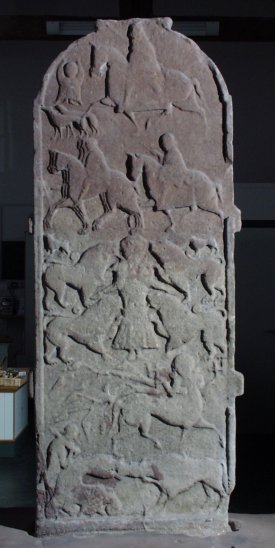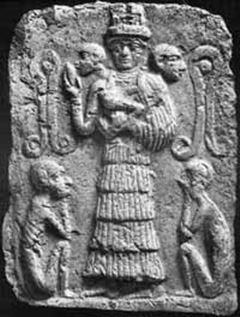It looks like you're using an Ad Blocker.
Please white-list or disable AboveTopSecret.com in your ad-blocking tool.
Thank you.
Some features of ATS will be disabled while you continue to use an ad-blocker.
share:
reply to post by Logarock
Yes, that's the one. Hang on, first though, this is the first time anyone has ever described the Meigle stone as you just did, Log -in every single article she is described as being ripped apart -some even call it the 'Daniel' stone, as in Daniel and the lions' den.
This is yet another ATS first, because you're right!!! They are showing respect, their arms are up - she is in command of them almost.
And yes, we could be mad already, lol!
And yes, curiously they are monkeys on the back of the lions, and if I'm not mistaken there's a monkey on another stone which I will find - here it is:
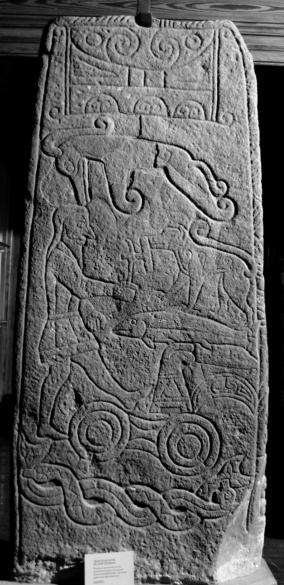
Yes, that's the one. Hang on, first though, this is the first time anyone has ever described the Meigle stone as you just did, Log -in every single article she is described as being ripped apart -some even call it the 'Daniel' stone, as in Daniel and the lions' den.
This is yet another ATS first, because you're right!!! They are showing respect, their arms are up - she is in command of them almost.
And yes, we could be mad already, lol!
And yes, curiously they are monkeys on the back of the lions, and if I'm not mistaken there's a monkey on another stone which I will find - here it is:

reply to post by beansidhe
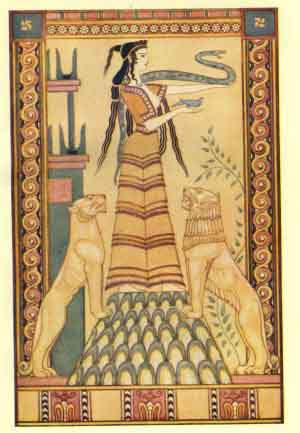
You were talking above about the "Daniel" stone. To me its very clear that for ages the artist always sowed whatever animal it was actually biting the subject if that was the intent, as to avoid confusion.
Crete

You were talking above about the "Daniel" stone. To me its very clear that for ages the artist always sowed whatever animal it was actually biting the subject if that was the intent, as to avoid confusion.
Crete
Another element which entered into the ethnic fusion in Mycenæan Greece was the Danubian. The influence of Danubian culture extended as far south as Thessaly, where the Achæans were predominant. These Achæan pastoralists were drifting southward into the Peloponnesus as early as the Late Minoan I Period, and some of them may have reached Crete. But their greatest migration appears to have occurred at the close of the Pelopid Dynasty, and it is probable that they were the late conquerors of Mycenæ and Tiryns. After holding sway in the Peloponnesus for a period of uncertain duration, they were overthrown in turn by the Dorians.
The second raid was of great dimensions. It included the Danauna, the Danaans, the Shakalsha, the Tursha, the Tikkarai, who may have come from Zakro in Crete, and the Pulesti, the Philistines. The sea force which sailed south by Cyprus was supported by land raiders from North Syria and Anatolia. Among the latter were the Philistines, who gave their name to Palestine. Rameses III won victories on sea and land, being assisted by the raiders' kinsmen, the Shardana mercenaries.
edit on 27-3-2014 by Logarock because: n
reply to post by beansidhe
Yes like we see some dogs attacking in some of the Pict stones. Celts were always known for war dogs. I suspect wherever we find a motif of dogs attracting we have Celt influence. There are also some bulls being attacked and deer I believe in Pit stones.
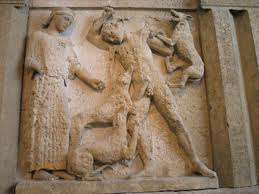
This is at Palermo. I had already posted this before. These temple works may be considered a bit high brow for Celts but it just may represent the extent and magnitude of Celtic capacity at one time. This may be mistaken for pure Greek influence but as we know the Celts were right in the thick of Greece.
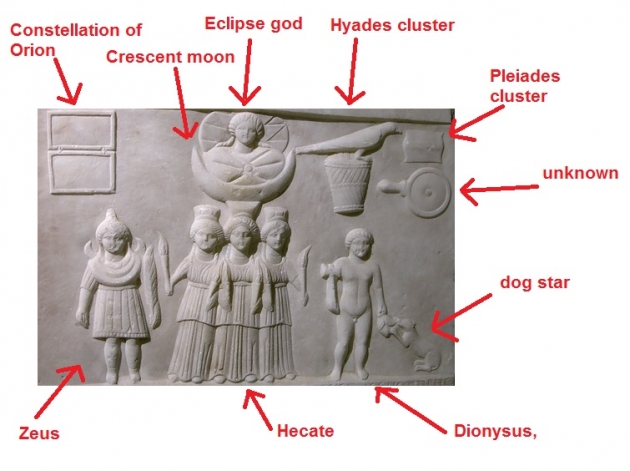
On this thing again, the mirror must be a lunar, reflective and feminine sort of thing. Here again thought to be Greek I believe but again the Celts were very much a part of Greece. In effect it is a Solar thing, the feminine of same, lunar reflection. In one Pict that I will have to dig out the famine wife, pic your name lol, is shown reclining with Sol. This reclining and embracing was taken to the personal level in these kingdom especially by the Etruscans as seen in their sarcophagi collection. We find man and wife interred together and represented on the lid in fine carving as Sol and his Lunar lady.
Whats to note in the Pict stones is the, I believe, total absence, save for one case and that case being king and queen seated and facing one another, of a male central figure in most the art. Lets just say there is an abundance of the feminine central figure. Again simply pointing out the strong Med influence. Carthage itself was founded by a Queen and look at the major work there undertaken in her name. Caring out of solid stone an entire sea port!
Yes like we see some dogs attacking in some of the Pict stones. Celts were always known for war dogs. I suspect wherever we find a motif of dogs attracting we have Celt influence. There are also some bulls being attacked and deer I believe in Pit stones.

This is at Palermo. I had already posted this before. These temple works may be considered a bit high brow for Celts but it just may represent the extent and magnitude of Celtic capacity at one time. This may be mistaken for pure Greek influence but as we know the Celts were right in the thick of Greece.

On this thing again, the mirror must be a lunar, reflective and feminine sort of thing. Here again thought to be Greek I believe but again the Celts were very much a part of Greece. In effect it is a Solar thing, the feminine of same, lunar reflection. In one Pict that I will have to dig out the famine wife, pic your name lol, is shown reclining with Sol. This reclining and embracing was taken to the personal level in these kingdom especially by the Etruscans as seen in their sarcophagi collection. We find man and wife interred together and represented on the lid in fine carving as Sol and his Lunar lady.
Whats to note in the Pict stones is the, I believe, total absence, save for one case and that case being king and queen seated and facing one another, of a male central figure in most the art. Lets just say there is an abundance of the feminine central figure. Again simply pointing out the strong Med influence. Carthage itself was founded by a Queen and look at the major work there undertaken in her name. Caring out of solid stone an entire sea port!
edit on 27-3-2014 by Logarock because: n
reply to post by beansidhe

Looking a this further.....it has the central figure as the "eclipse god". This must be lunar eclipse if so and looks to be in the feminine.
Anyway there are two part of the "cartouche" here as in the Pict stone. We could probably find the bird and basket somewhere if we have a good hit. At any rate event his work above many be a simple personal cartouche and not simply religious art work.
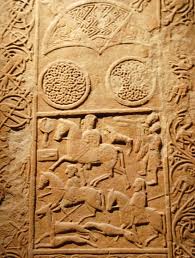

Looking a this further.....it has the central figure as the "eclipse god". This must be lunar eclipse if so and looks to be in the feminine.
Anyway there are two part of the "cartouche" here as in the Pict stone. We could probably find the bird and basket somewhere if we have a good hit. At any rate event his work above many be a simple personal cartouche and not simply religious art work.

reply to post by beansidhe
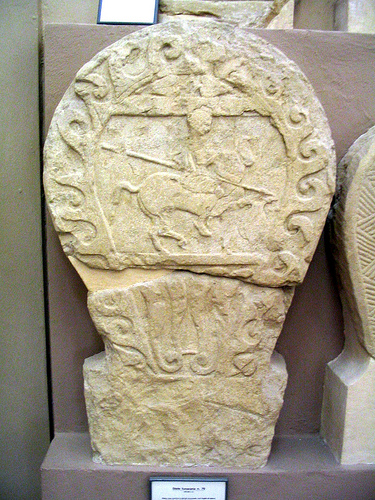
Here is an Etruscan maybe Carthaginian tomb stone or marker. Note it was broken but note the tails of sea horse like those found in Pict stone. Now compare to below.
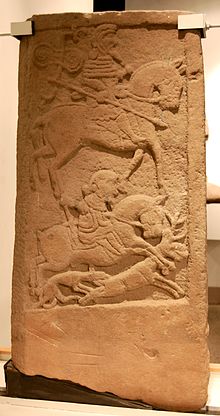
Same basic representative style. Note here is a central Pict figure that is male contrary to what I said above about the almost total female aspect represented in Pict art.

Here is an Etruscan maybe Carthaginian tomb stone or marker. Note it was broken but note the tails of sea horse like those found in Pict stone. Now compare to below.

Same basic representative style. Note here is a central Pict figure that is male contrary to what I said above about the almost total female aspect represented in Pict art.
reply to post by Logarock
Here's the whole stele:
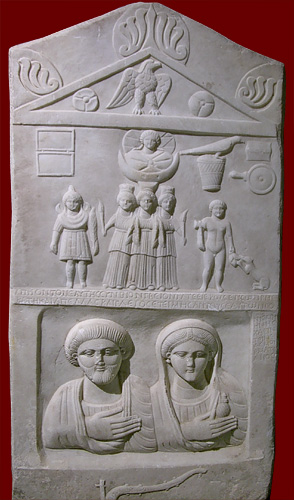
Hecate stele
Here's the whole stele:

marble funerary stele of a couple, from Soa (modern Altintas in Turkey), Roman period
The Greek inscription reads "Aphion dedicated her husband, Gaius, to the savior Hecate, and Apellas and Gaius have honored the memory of their parents." The stele is signed by the stone cutter. The couple are shown in a traditional pose, and the wife holds in her hand a distaff and spindle, symbol of feminine virtue. Above them, are beautifully carved symbols of daily life, including a wax tablet on the left, and on the right a bird standing on a wool basket, a comb, and a mirror. The eastern religious cults are depicted in the central figures, including the two young males carrying lunar symbols, and the figure of Artemis Pergaia/Diana Pergensis, with her head surrounded by a rayed halo and the symbol of the crescent moon, imported from Perge, capital of Pamphylia. The most important deity, however is Hecate, the triple-bodied goddess who is Diana's underworld representative, to whom Aphion dedicated the spirit of her husband.
Istanbul, National Archaeological Museum. Credits: Barbara McManus, 2007
Hecate stele
reply to post by beansidhe
Hay, do you want to call that the "Hecate" cartouche for the time being? She has so many names its true but maybe we should pick one. Maybe the Pict stones were applicable are Hecate stones.
Hay, do you want to call that the "Hecate" cartouche for the time being? She has so many names its true but maybe we should pick one. Maybe the Pict stones were applicable are Hecate stones.
edit on 27-3-2014 by Logarock because: s
reply to post by Logarock
I'm going to dig out the rest of the stones with the mirrors so we can have a proper look and compare them.
the sea horse tails (like Hathor's hair design) are too prolific to be ignored, they are just identical
On this thing again, the mirror must be a lunar, reflective and feminine sort of thing. Here again thought to be Greek I believe but again the Celts were very much a part of Greece. In effect it is a Solar thing, the feminine of same, lunar reflection.
I'm going to dig out the rest of the stones with the mirrors so we can have a proper look and compare them.
the sea horse tails (like Hathor's hair design) are too prolific to be ignored, they are just identical
reply to post by beansidhe
I had the thought, with your find in view, that we may have to consider a tighter time line considering the cartouche is really identical to the Pict example. Plus in that you have an eagle nearly like the one on a Pict stone you have shown. Naturally this doesn't mean that its use couldn't have been around for a while before Roman Anatolia. At any rate it looks like a strong direct line of contact with the "Picts" on the scale of the rampant dragon. Celtic tribal Warlords, not to honky cat them, recognized throughout the Celtic world in and of known Celtic cultural centers from Greece to France, Spain, Italy, the Balkans, Germany...... to Scotland. That's quite an empire really and before Rome stood up these Celts moved about freely within thier own over this wide swath east to west in the Med North to Scotland, Ireland. Lots of turf there.
I need to leave off for the rest of the day. Maybe add late tonight.
I had the thought, with your find in view, that we may have to consider a tighter time line considering the cartouche is really identical to the Pict example. Plus in that you have an eagle nearly like the one on a Pict stone you have shown. Naturally this doesn't mean that its use couldn't have been around for a while before Roman Anatolia. At any rate it looks like a strong direct line of contact with the "Picts" on the scale of the rampant dragon. Celtic tribal Warlords, not to honky cat them, recognized throughout the Celtic world in and of known Celtic cultural centers from Greece to France, Spain, Italy, the Balkans, Germany...... to Scotland. That's quite an empire really and before Rome stood up these Celts moved about freely within thier own over this wide swath east to west in the Med North to Scotland, Ireland. Lots of turf there.
I need to leave off for the rest of the day. Maybe add late tonight.
reply to post by beansidhe
One more thing. Who was the first man to set foot on something off the earth, the moon? A Scotsman? Neil Armstrong?
One more thing. Who was the first man to set foot on something off the earth, the moon? A Scotsman? Neil Armstrong?
reply to post by Logarock
He was. A Celt from Ohio like your good self, lol!
I'll gather up these mirrors and catch up soon
He was. A Celt from Ohio like your good self, lol!
I'll gather up these mirrors and catch up soon
Logarock
...Those beast look like Lions. And just what are those small beasts riding on the back of the top two beasts? Monkeys? ....
Hi Log,
I've got quite a good photo of that stone in a book here in front of me, and to my untrained eye the small beasties on the Lions backs look like they could be more like dogs?
I'm looking at: The head shape, deep chest, narrow loin, the shape of the rear leg, the paws...
The tail is certainly monkey-like, but then some dogs do have long curled tails too?
Also when I first saw the photo, and the "Daniel" description, I couldn't understand why it looked like the central figure was "petting" the two lower lions?? His hands look like they're resting on the lions heads?
Surely you wouldn't do that if being attacked or devoured???? LOL
I'm definitely with you on the Lions showing respect to the figure.
Do we know who the figure actually is??
Here are some "birdmen" for Beans too.. (sorry about the poor cameraphone - it is NOT Pictish, but was perhaps contemporary!)
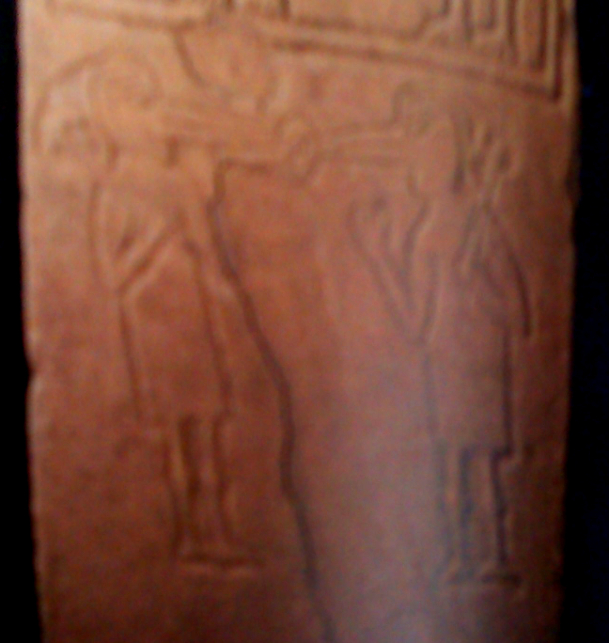
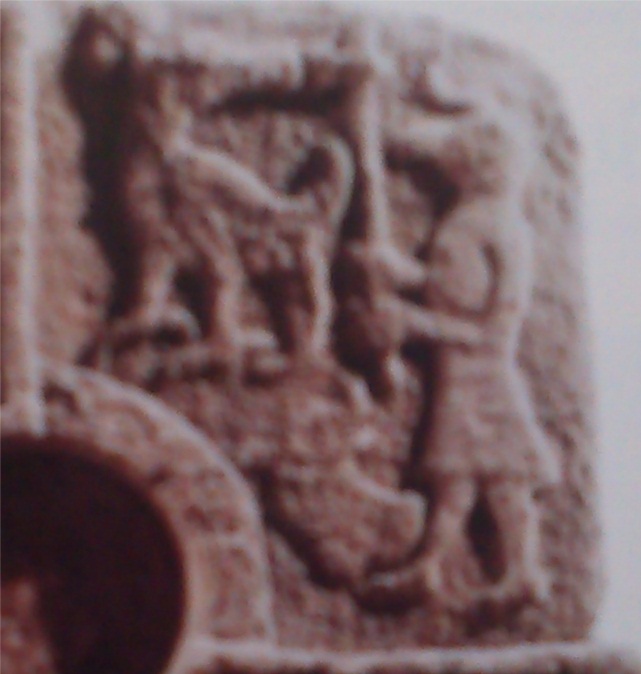
I had a giggle at the next one.... Can anyone tell me how the hunters in the top right managed to get their hands on high-powered hunting rifles with scopes???
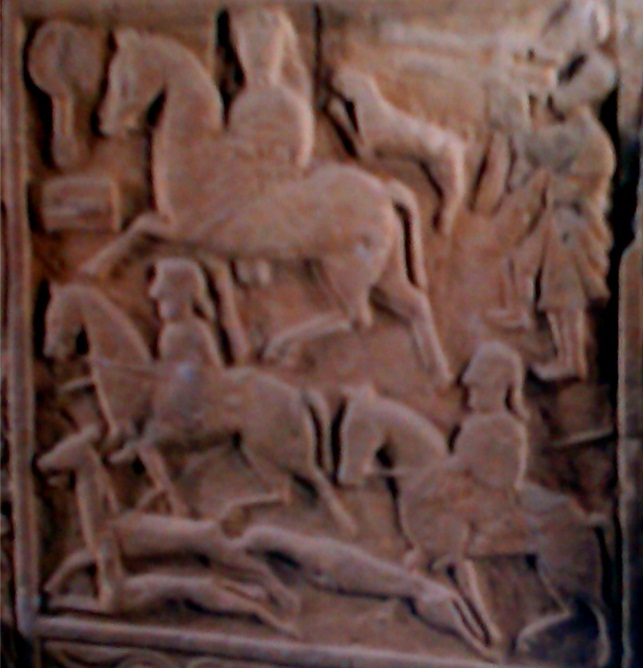
Now THAT is clever!! LOL
reply to post by Gordi The Drummer
Hey Gordi,
I'd wondered if they were Mug Ruith earlier on, although I wasn't clear why there were two?

Similarly this could have been Mug Ruith fighting Cu Chulainn, the Hound of Ulster?

But again, I'm not certain, really. I read something about dogheads the other day, now where was it? It reminded me of the Wulvers in Shetland (wulvers, ahem).
Hey Gordi,
I'd wondered if they were Mug Ruith earlier on, although I wasn't clear why there were two?

Similarly this could have been Mug Ruith fighting Cu Chulainn, the Hound of Ulster?

But again, I'm not certain, really. I read something about dogheads the other day, now where was it? It reminded me of the Wulvers in Shetland (wulvers, ahem).
Logarock
reply to post by beansidhe
Hay, do you want to call that the "Hecate" cartouche for the time being? She has so many names its true but maybe we should pick one. Maybe the Pict stones were applicable are Hecate stones.
edit on 27-3-2014 by Logarock because: s
Yes, let's do that
I have to back up for a minute.
From earlier post to Rickymouse:
"And, another Thracian link (from Logarock's link):
Hippolytus tells us that the Celts learned Pythagoreanism from a Thracian?
Then is it possible that this 'cauldron':

Is in fact this?

Counter-Earth
From earlier post to Rickymouse:
"And, another Thracian link (from Logarock's link):
However, the triskele is a symbol of harmony and unification, not only in mythology, but also in geometry, its form and method of construction being a perfect example of the Golden Ratio (also called the golden section (Latin: sectio aurea), so central to the mathematical and religious movement called Pythagoreanism, with which the Celts were familiar:
“And the Celtic Druids investigated to the very highest point the Pythagorean philosophy, after Zamolxis, by birth a Thracian, a servant of Pythagoras, became to them the originator of this discipline. Now after the death of Pythagoras, Zamolxis, repairing thither, became to them the originator of this philosophy. The Celts esteem these as prophets and seers, on account of their foretelling to them certain (events), from calculations and numbers by the Pythagorean art”.
(Hippolytus. “Philosophumena” XXII) "
Hippolytus tells us that the Celts learned Pythagoreanism from a Thracian?
Then is it possible that this 'cauldron':

Is in fact this?

Revolving around the Central Fire above Earth were the Moon, the Sun, the planets, and finally—perhaps fixed and not rotating at all—were the stars. Revolving around the Central Fire below Earth was another hypothetical astronomical object, the Counter-Earth. Whether Philolaus believed Earth to be round or flat—there is "no explicit statement about the shape of the earth in Philolaus' system"[5]—he did not believe the earth rotated, so that the Counter-Earth and the Central Fire were both not visible from Earth's surface—or at least not from the hemisphere where Greece was located.[3]
Counter-Earth
reply to post by Gordi The Drummer

From The Gododdin.
And in the Taliesin, the Dogheads

Dogheads
Maybe?

I saw the two who from their station quickly fell;
By the commands of Nwython greatly were they afflicted.
I saw the men, who made a great breach, with the dawn at Adoyn;
And the head of Dyvynwal Vych, ravens devoured it.
From The Gododdin.
And in the Taliesin, the Dogheads

Manawydan is mentioned in the poem known as "Pa gur yv y porthaur" ("What Man is the Gatekeeper?"), where he is named as one of the warriors in King Arthur's retinue.[2] The poem praises him as providing worthy counsel and for splintering shields at a place called Tryfrwyd; later in the poem this battle is associated with cinbin or dogheads and a figure known as Garwlwyd
Dogheads
Maybe?
I think I might have found something - possibly.
The lyre is frequently depicted in celtic art.
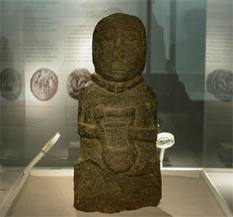
But it has it's own symbol (RHS):
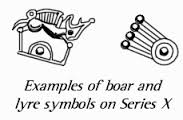
The Lyre in Celtic Art
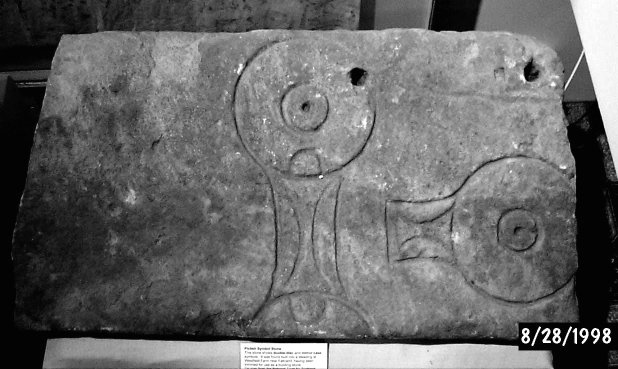
This would then be depicting double sun and single sun (shining to the west?)
The lyre is frequently depicted in celtic art.

But it has it's own symbol (RHS):

The lyre as an attribute of Apollo, is well known, and the association of lyres and depictions of Apollo on Greek coins is common. The earliest Celtic gold staters are derived from the staters of Philip of Macedon and show, on the obverse, the head of Apollo. The design lasted, in abstract form, to the end of Celtic coinage in Britain.
While the Macedonian coins did not have a lyre as part of the design, there are a number of depictions of Apollo in Gaul during the Roman period. He is shown nude, and with his lyre, but often these images are associated with healing springs. Some inscriptions refer to healing hot springs, and even today we have a famous mineral water containing the name of Apollo. Caesar informs us that the Celts, like other nations at the time, had the idea that Apollo averts illness. All of this gives weight to the opinion that lyres on Celtic coins are merely a reference to Apollo. That the lyre on its own seems to refer to Apollo as the god of music should alert us to a problem with this symbol, and possible references to health and healing springs are unlikely subjects to find on coins.
Treating symbols in isolation, without taking the context in which they appear, or their substitution with other symbols in a particular coinage, can lead to a pastiche of interpretation where many gods and myths seem to be fighting for dominance even on a single coin. Such a situation, if believed, belies the very character of Celtic art, which could be expressed as multiple variations on a theme
Celtic art on coins reached its greatest expression in Armorica, and although other regions have produced very beautiful coins, it is in Armorica that we consistently find the most complex designs. Lyres are also fairly common on Armorican coins. The lyre symbol usually has four "strings" or lines emanating from a sound box consisting of a pellet within a circle. The latter element is a well known sun symbol, and thus appropriate to an attribute of Apollo. Some inscriptions from Roman Gaul have Apollo's epithet as "Grannos", which has been connected to the sun. John Rhys makes the following connection:
Grannos is probably to be referred to the same origin as the Sanskrit verb ghar,"to glow, burn, shine; "ghrna, ghrni," heat, glow, sunshine.
With this translation we can combine both the sun and hot springs. The presence of the lyre, while it may be understood merely as an attribute of Apollo, seems to be given greater significance on Armorican coins.
The Lyre in Celtic Art

This would then be depicting double sun and single sun (shining to the west?)
new topics
-
President Carter has passed
Mainstream News: 1 hours ago -
Get Reday - Here comes the Bird Flu Pandemic - Millions are Notified
Diseases and Pandemics: 2 hours ago -
2 Guys die hunting Bigfoot
Cryptozoology: 2 hours ago -
Joe Rogan and The Black Keys Diorama
General Entertainment: 4 hours ago
top topics
-
Get Reday - Here comes the Bird Flu Pandemic - Millions are Notified
Diseases and Pandemics: 2 hours ago, 9 flags -
President Carter has passed
Mainstream News: 1 hours ago, 9 flags -
Joe Rogan and The Black Keys Diorama
General Entertainment: 4 hours ago, 3 flags -
2 Guys die hunting Bigfoot
Cryptozoology: 2 hours ago, 3 flags
active topics
-
Get Reday - Here comes the Bird Flu Pandemic - Millions are Notified
Diseases and Pandemics • 10 • : network dude -
2 Guys die hunting Bigfoot
Cryptozoology • 8 • : StudioNada -
President Carter has passed
Mainstream News • 8 • : CriticalStinker -
Kurakhove officially falls. Russia takes control of major logistics hub city in the southeast.
World War Three • 32 • : RickyD -
Danish Prime Minister said to keep 3 days worth of canned goods on hand
World War Three • 14 • : Xtrozero -
Why Such An Uproar Over Non-US Citizens With H1-B Work Visas.
Social Issues and Civil Unrest • 62 • : Kaiju666 -
Trump's idea to make Canada the 51st US state: 'Potential is massive'
Mainstream News • 120 • : Xtrozero -
Mexico Plans Alert App For Migrants Facing Arrest In US
Mainstream News • 11 • : marg6043 -
-@TH3WH17ERABB17- -Q- ---TIME TO SHOW THE WORLD--- -Part- --44--
Dissecting Disinformation • 3842 • : Guyfriday -
Joe Rogan and The Black Keys Diorama
General Entertainment • 4 • : nugget1

